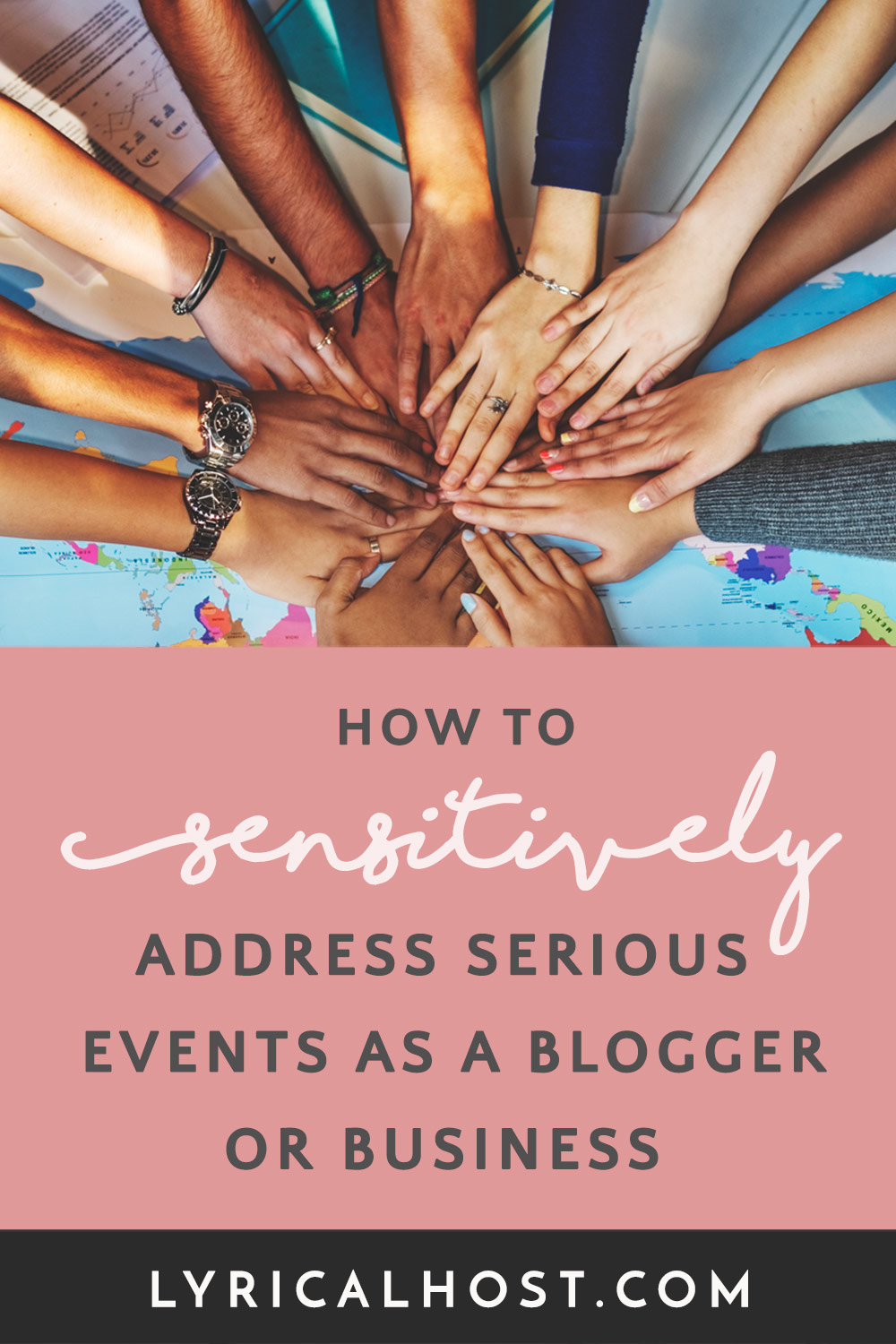In this post we look at what to think about when discussing sensitive subjects, some of the approaches you may want to explore, and how you can use your platform in a way that feels authentic.
One of the first questions people have is, “How do I know when to discuss a sensitive current topic?” When there are so many events and issues all over the world, and we’re connected to everyone, it can be hard to make the call. If the event directly impacts you or relates to your work or content in some capacity, it’s likely that you’ll be talking about it. If it’s a large-scale event or one likely to last more than a couple of days, you may also want to address it. Finally, if you think your audience expects to hear from you on a particular topic, it’s something you want to meet their expectations on. You don’t have to wait to see what everyone else is doing – work in a way that feels right for you.
Currently reading: How To Sensitively Address Serious Events As A Blogger, Influencer or Business Click To TweetYour authentic and thoughtful response is another way to connect with your community and co-support. Not only can this really help you get through hard times, it’s creating more happiness for everyone even in the darkest moments.
There is no one-size-fits-all answer; what you say should be authentically tailored to your own unique perspective, audience, and blog/business.
Below we cover:
- Deciding your position (even if you choose not to mention anything, that still needs to be a conscious choice);
- How to determine what to say and when;
- Handling comments and responses, especially criticism (and why people may respond that way);
- Practical vs emotional responses;
- Misinformation and verified sources.
Finding the balance
If you’re speaking about something you’re not directly involved in or that isn’t directly related to what you normally do, it can be tricky to navigate. You don’t want to be seen as jumping on a bandwagon or virtue signaling, but you also don’t want to be insensitive.
People often react from one extreme to the other, from “Why are you talking about X, stick to [your industry/niche]” to “Why aren’t you saying anything about X, it’s such a bad look. You can do better.”
The main reason behind this is because people naturally react to these situations with a “fight or flight” response, even if they’re not physically experiencing the situation. Online, “flight” looks like people avoiding social media (or maybe even the internet altogether), refusing to discuss situations, muting/unfollowing accounts based on the subject, preferring to hang out in corners of the internet that are completely unrelated to the situation and so on. “Fight” may be sharing things to rally people together, getting involved in debates, posting angry comments etc. People who are naturally fighters can lash out because they’re frustrated, and you may end up being the target of that even though it’s not about you and the original situation is completely beyond your control.
Recognizing whether someone is a “flight” or “fight” type of person (and if you have a small audience, which way it generally leans), can help you provide the type of content that’s best suited to them. For example, a “fighter” may want links to protests and a “flight”er may prefer a tangentially related positive quote. Responding to a negative comment from a “fighter” will probably lead to more fighting, whereas trying to involve a “flight”er in a sensitive discussion is more likely to lead to them disappearing altogether.
Deciding on your approach
You may want to develop your own specific approach to sensitive situations that covers a broad range of news events (for example, you’ll write one post or email initially, and then a follow up with ways to help), or you may want to tailor it to each situation.
Or, you may want to explain why you’re not talking about the subject and provide links to resources and support for people who do want to discuss it. There are many totally valid and understandable reasons why you may decide against using your own platform to highlight a subject, especially if it’s highly triggering for you or your audience (for example if your calling lies with PTSD or domestic violence survivors).
If you have multiple blogs or businesses, or you have personal and professional profiles, you may decide that it’s appropriate for some places but not others. In these instances you could direct people to the conversation there, or simply mention to people enquiring where you’ve raised the situation instead.
It’s essential to factor in your followers/visitors/customers as much as possible. Is the specific event likely to affect them? How will they be reacting to it? Are you in a position where they’re expecting you to take a stand? Will they be looking to you for support or guidance? Is it a situation where you can provide practical help or a genuinely helpful gesture?
Another thing to consider is the nature of what’s happening. Will it be something that needs to change about society/a minority or vulnerable group that involves long-term focus and progression? Or is it a natural disaster or world event that may last a few days or months? This may affect the speed and type of your response (for example, in a tsunami or hurricane you’re going to want to respond quickly, whereas a political situation that’s still developing may be something you want to monitor but not gut-react to until it’s clear all the information is there).
It’s vital that you’re making a conscious choice – however you choose to approach it – and that your response is both timely and sensitive to the situation. Ultimately, you’re in a position where people are expecting you to be a role model, whether you see yourself as that or not. This is a lot of responsibility to bear, especially when there’s no training on this kind of thing, and people will have so many different opinions on whatever it is you choose to do.
In many situations it’s likely that your followers/customers will be on a similar page to you. In others, there may be very split strong opinions that divide your audience. For example, your audience may fully support black voices being more amplified, but be split 50/50 on whether the UK should have left the EU.
Even in situations where you have wide-scale agreement, there can be differences in how people think that should be handled or what people are in favor of you supporting. For example, people may feel like a particular sub-group or organization doesn’t align with their views, or that while they’re against a war, they think humanitarian aid is a better approach than military donations (or vice versa).
What to say
The most important thing is that you’re coming from a place of authenticity. It’s immediately obvious if you don’t really care or your reasons are to pacify/look good to your audience rather than because you care deeply about the topic. At the same time, you’re likely not a professional diplomat or backed by a team of people approving what you say or writing it for you. Neither are you going to care just as deeply about every single event or situation because we don’t have the capacity or emotional bandwidth with so many things happening daily; you naturally react differently to different things. It’s easy to mess up, or be in an impossible situation, so don’t beat yourself up or second guess if nothing seems to feel “right.” A lot of the time, there is no “right,” and a lot of unknowns.
Additionally, being affected by situations yourself can make it harder to find the words because you’re very emotional, or all your energy is going to directly dealing with a crisis or helping those around you in person. Finding the right words with your audience may be the last thing you have the time or capabilities to do, but it’s very easy for people to assume you’ve deliberately chosen silence when you’re overwhelmed. In this instance, you may want to just describe how you feel. Be honest with your audience or customers and tell them that you’re in shock or still processing everything, and that you’ll follow up with more when you’ve had a chance to gather your thoughts. In the meantime, you could just share someone else’s post that represents your thoughts, a photo, or a list of ways to help from a trusted relevant organization.
When what you say isn’t being directed by how you feel, for example when you’re sympathetic to something on the other side of the world but it’s not something you can personally relate to or have relatable experience of, focus on how you want your audience to feel instead. This may be in the form of reassurance, or showing you stand with them, or offering your support in a meaningful way.
In some situations you’re just not going to know enough or understand enough of the cultural context or experience to be able to say something that resonates with people or is authentic. In these circumstances, don’t try to pretend to be something or someone you’re not. Stand authentically and show what you’ve been doing to learn and understand more about the context, and how people in the same position as you can research or help more.
One option is to have some general quick reference information stored in your highlights, media library, on your phone or similar, so that you can point people to relevant guidance quickly. This could include things like mental health resources, links to charities, key emergency numbers for an area and so on. Pinning, using highlights, or having header or sidebar space on your site dedicated to a sensitive situation or ways to get help means that even if someone misses a one-off post or Story, they can still access the information easily and know you’ve spoken about it.
Where to say it
This is likely to come down to:
- Where your audience primarily goes to find you (e.g. your blog, a particular social network).
- How much you’re planning to talk about it (if you have a lot to say, you’re going to want to choose a long-form medium such as a blog post, email, video etc. as opposed to tweets).
- The nature of your communication (if you’re sharing other people’s posts, social media is likely the best spot).
- How likely it is you’ll want to add to (or potentially correct) your content.
- How public or private you want it to be – some discussions you may want to have public for reach; others you may want to have specifically with your audience.
- What your relationship with your community or customer-base is like; it may be you work one-to-one with a small number of clients and prefer to have individual discussions with each.
- What assets you have – for example if you have a group or membership, it may be that you want to open up a safe space for ongoing discussion there, or to keep everything together in one place so people are free to take part or scroll past.
Providing information
Everything you post will likely be from the same one or two perspectives: logical, or emotional. In the sections above a lot of what we’ve addressed is emotional, but there are also many valid logical options too.
This could be in the form of:
- Ways to donate (either money or supplies).
- Contact information for writing to members of Parliament or Congress.
- Links or information about relevant events (or how people can find events local to them if that’s more relevant, for example for peaceful protests).
- Trusted websites, articles, videos, podcasts, documentaries or books.
- Practical advice as relevant to the situation (e.g. how to prepare for a hurricane or reducing virus spread or how to spot disinformation online).
- How your followers and customers can help other people (asking them to share, or passing on information to people who aren’t as tech-savvy or don’t use social media and so on).
Always share information from trusted sources, be mindful that people in different locations are likely to need different local resources, and don’t post things where you aren’t sure of the authenticity. A blue tick or other verified checkmark doesn’t mean that the account owner has checked or verified what they’re sharing either, so it still may not be true. The same is true of accounts or posts with a lot of shares or reactions – just because a lot of people have responded doesn’t mean the information is true. Official fact-checking organizations and groups such as fullfact.org can be useful in these situations, or high-quality regulated news sources.
If something hits you emotionally, such as an image of children or animals, acknowledge the emotion and then try to take a step back. Sometimes such words or images are deliberately intended to manipulate, and so you may want to verify that it’s real before your instinct to hit the share button or comment kicks in.
Responding to criticism
In many situations, people are likely to be experiencing stronger emotions at a more extreme level. If they’re hurting or feeling powerless because of bigger events or situations, they will often reach for an easier target instead, or not even realize that they’re doing that. Although it may often seem personal and it’s hard not to take direct criticisms or insults personally, you have to detach from negative comments as best you can and resist matching their energy.
If you’re in one of these situations, sometimes people just want to feel heard or to hear you’re planning to do something differently and how you’re going to achieve that. If it looks like it’s not going to be a constructive discussion and/or they’re just being abusive, it may be better to ignore, block or delete to avoid further escalations. Another option is to gently push the conversation back on track by explaining that you don’t want to make it about you, and switching the focus.
To diffuse rather than escalate situations, avoid excuses. For example, saying that you haven’t spoken about it because you’ve been “really busy with XYZ” is likely to ignite someone further and see other people get involved who normally wouldn’t. These kinds of situations often come out of nowhere and you don’t get any warning or much time to think about a response, so unfortunately it’s impossible to prepare in advance – you’re always going to have been busy with something, everyone always is. Instead, just be honest, say that you got it wrong and how you plan to do better.
At the end of the day it’s your choice how you respond to events and situations, but one of the things that will help you the most is taking the time to think about your response and actioning what you’ve decided on so you’re not on the back foot or reacting in a rushed or slapdash way. You’re in the position of being a leader, so you need to be the one stepping up first and opening the conversation.
A quick checklist
Now we’ve looked at some strategies and the reasoning behind them, you should feel more confident in approaching a sensitive situation with your audience or customers. Here’s a quick checklist of questions to ask yourself that cover the main points above:
01. Are you addressing this issue (why or why not)? (Explain this to your audience).
02. Do you have enough information about the situation to have an opinion or message?
03. How are you contributing or helping in a positive way (without making it about you)?
04. Are you confident the information you have is valid and accurate?
05. Have you decided what/how much you’re going to post?
06. Is it from a practical or emotional place, or both?
07. Have you got a friend or family member who can quickly read over your post to check it’s respectful and sensitive of the situation?
08. Do you have appropriate content warnings if needed?
09. How are you planning to handle comments and responses? (This may include turning commenting off or restricting it).
Want to come back to this later or share it to help someone else? Pin it:







Roman B
I think I’m commenting fairly late on this post, but this is really helpful advice! There’s so much going on globally, having an guide to help navigate heavy conversations is a great idea, I’ll definitely be keeping this bookmarked and recommending it to others. You clearly put a lot of work into this!